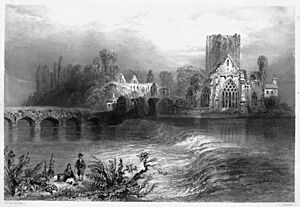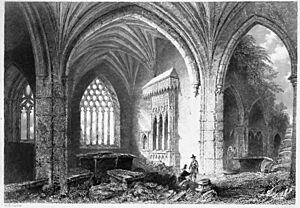Holy Cross Abbey facts for kids
| Mainistir na Croise Naofa | |

Holy Cross Abbey on the River Suir
|
|
| Monastery information | |
|---|---|
| Order | Cistercians |
| Established | 1168 |
| Disestablished | 1536 |
| Reestablished | 1969 |
| Diocese | Cashel and Emly |
| People | |
| Founder(s) | Domnall Mór Ua Briain |
| Architecture | |
| Heritage designation | National Monument |
| Style | Cistercian |
| Site | |
| Location | Holycross, County Tipperary, Ireland |
| Coordinates | 52°38′23″N 07°52′00″W / 52.63972°N 7.86667°W |
| Public access | yes |
Holy Cross Abbey (which means Mainistir na Croise Naofa in Irish) is an old Cistercian monastery. It is located in a place called Holycross, near Thurles in County Tipperary, Ireland. The Abbey sits right by the River Suir. It got its special name from a very important religious item: a piece believed to be from the True Cross. This is the cross that Christians believe Jesus was crucified on.
Contents
A Look Back in Time
The Abbey's Beginning
A small piece of the True Cross was brought to Ireland around the year 1233. It was brought by Queen Isabella of Angoulême. She was the wife of King John. Queen Isabella gave this special relic to the original Cistercian monastery in Thurles. This monastery was first started in 1169 by King Donal O'Brien of Thomond. Queen Isabella then helped to rebuild the monastery.
A Place of Pilgrimage and Hope
Over time, Holy Cross Abbey became a very important place. Many people went there on pilgrimage to see the sacred relic of the True Cross. During the Protestant Reformation, a time of big religious changes, the Abbey became a symbol of hope. It was a place where people who were facing religious difficulties could gather. It stood for defending the Catholic faith and fighting for freedom.
In 1567, Sir Henry Sidney, who was a high-ranking official in Ireland, even complained to Queen Elizabeth I about how many people were gathering there.
In 1601, an Irish prince named Hugh Roe O'Donnell visited the Abbey. He was on his way to a big battle called the Battle of Kinsale. He honored the relic of the True Cross there. At that time, the Abbey was a meeting point for people who wanted religious freedom and for Ireland to be independent.
The Abbey Falls into Ruin
The Holy Rood relic was last shown to the public in 1632. After a war led by Oliver Cromwell, Holy Cross Abbey became a ruin. From about 1740, local people used the roofless Abbey as a burial ground.
In 1880, it was made a national monument. This meant it had to be protected and could not be used as a place of worship anymore.
Bringing the Abbey Back to Life
However, something special happened in 1969. The Irish parliament, called the Dáil, passed a special law. This law allowed Holy Cross Abbey to be restored and used again for Catholic worship. This was very unusual for a national monument.
A new, authenticated piece of the Holy Cross was given to the Abbey from the Vatican. The symbol of the Jerusalem Cross, also known as the Crusader Cross, was also brought back for the Abbey.
The Cross is Stolen and Found
On October 11, 2011, two crosses were stolen from the Abbey. One of them was the cross holding the relics of the True Cross. Thieves used tools to take the relics. Luckily, in January 2012, the relics of the True Cross were found and brought back to the Abbey.
Gallery
Getting There
You can get to Holycross by bus. There is a bus route from Thurles to Clonmel that goes through Cashel. The closest train station is Thurles railway station, which is about 6 kilometers away.
See also
 In Spanish: Abadía de la Santa Cruz (Irlanda) para niños
In Spanish: Abadía de la Santa Cruz (Irlanda) para niños








